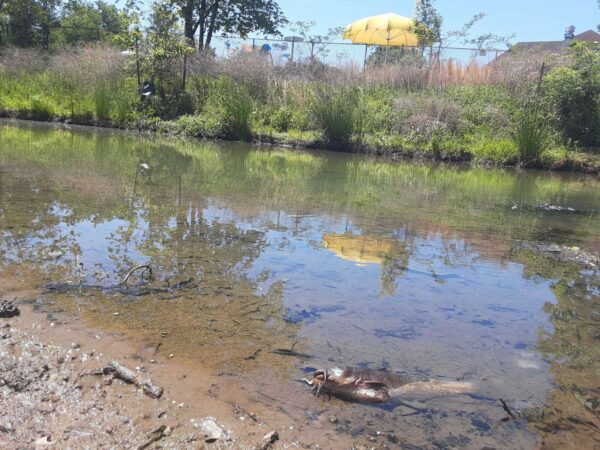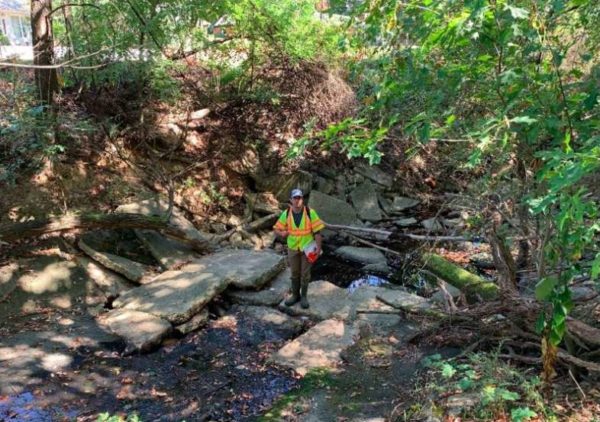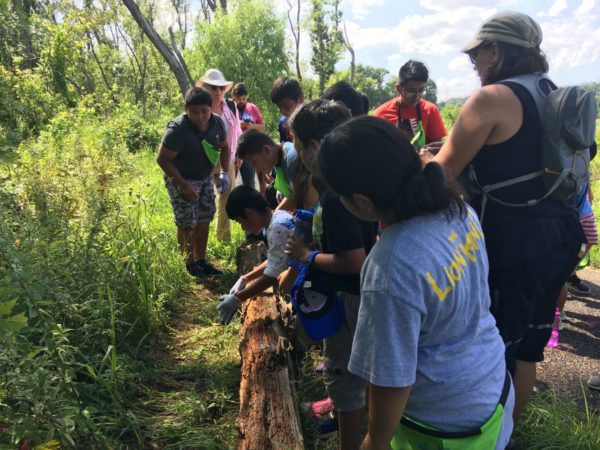There was a valve in Cameron Run Regional Park that wasn’t meant to be used. But two days ago, it was, and the result was a chemical leak into the adjacent Lake Cook that’s had a fatal effect on the park’s wildlife.
“There are two different pump stations and filter systems at Cameron Run, one for the main wave-pool and one for the shallow children’s pool,” explained Paul Gilbert, Executive Director of the Northern Virginia Regional Park Authority (NOVA Parks). “Each system is a little bit different, both designed so they never put chlorinated pool water into the lake.”
But a relic of an earlier, outdated system remained at the park, and an employee mistook it for part of the filtration system.
“Someone who was not as familiar with the system found a valve that would allow them to drain that pool,” Gilbert said. “It’s a valve that hasn’t been used in over 15 years since we put in the new system. They didn’t understand what they were doing, but that pool water went into Lake Cook.”
Gilbert said NOVA Parks staff were on-site yesterday with the city’s fire marshal to examine the impact and figure out what happened.
“We disabled the valve that allowed the pool to be drained,” Gilbert said. “Today, we’re out there with the contractor cleaning up Lake Cook.”
Gilbert said the contamination was a fish kill.
“It’s a small lake, Lake Cook, so it’s an issue of concentration,” Gilbert said. “Right now, we’re focusing on clean up.”
According to Alexandria communications officer Andrea Blackford:
The Fire Marshals Office (FMO) issued a notice of violation for the illegal discharge of approximately 60,000 gallons of pool water that contained a strong odor of chlorine. The FMO also ordered NOVA Waterpark staff to make necessary repairs to the sanitary drains and other drains prior to refilling the pools. Additionally, a notice of violation was issued for the illegal discharge of a blue substance used as a stain on the pool deck.
After reports of dead fish and birds along the banks of Lake Cook, officials have investigated and found high levels of chlorine contaminating the lake.
According to Raytevia Evans, senior public information for the Alexandria Fire Department, a HAZMAT team on site confirmed high levels of chlorination.
“We received notification yesterday evening about a visible fish kill and oil-like substance on Lake Cook” Evans said. “We sent out our HAZMAT team and fire marshal’s office to investigate. They are the ones who responded that there were high levels of chlorination detected.”
Images posted in the Bring Integrity Back to Alexandria Facebook group showed dead herons, catfish and more along the banks of the lake.
The lake is immediately adjacent to Cameron Run Regional Park, a water park planned to reopen this summer.
Staff at Northern Virginia Regional Park Authority said park management is currently on scene as officials continue to investigate.
James Cullum and Vernon Miles contributed to this story. Map via Google Maps
In response to the city’s public information meetings about the Taylor Run Stream Restoration project, local advocacy group Environmental Council of Alexandria (ECA) is hosting its own meeting tomorrow outlining its opposition to the plan.
The city is planning to overhaul the stream’s design to reduce erosion of the banks and cut down on the flow of pollution from the watershed further down the creek into the Potomac River. Critics of the plan, including the city’s own natural resource manager Rod Simmons, have questioned project contractor’s figures on the pollution in the stream and the benefit of the proposed changes.
The city has posted its own Q&A document with lengthy responses to some criticisms of the project.
The ECA is scheduled to host its meeting via Zoom tomorrow (Thursday) at 7 p.m., with attendees able to register online.
“The City claims that the project will impact only a narrow band of forest along the stream that can be restored easily by replanting thousands of young trees and shrubs,” the ECA said. “They continue to say that the project will rejuvenate the stream and the park ecologically, stop stream erosion, protect sanitary infrastructure, and prevent hundreds of pounds of phosphorus and nitrogen each year from reaching the Potomac River and Chesapeake Bay. But are any of these claims really true? We don’t think so. Join us for a Zoom presentation on February 25 to find out why.”
The city held a public meeting on January 28 which is viewable online. The project is not scheduled to return to City Council for further approval, although Mayor Justin Wilson said the issue could be revisited in the public hearing phase of budget discussions.
Photo via City of Alexandria
Taylor Run stream in pretty bad shape, but the City of Alexandria wants to revitalize it into a healthy stream rich with native vegetation.
“It’s in the design phase right now,” said Jesse Maines, division chief for Stormwater Management. Maines estimated the design was about halfway completed, but the department is still reaching out to local stakeholders and continuing internal discussions about the eventual design.
The stream starts near T.C. Williams High School and the Chinquapin Recreation Center, then runs parallel to King Street, eventually emptying into Cameron Run.
Maines said the stream has seen severe erosion over the years as new development has funneled ever-increasing amounts of stormwater through the ravine. There are places where the stream’s banks are a nearly 90-degree drop-off. Restoration of the stream will also help improve water quality to meet the Chesapeake Bay cleanup mandates, the city said on its website.
“We’re considering different kinds of techniques,” Maines said. “This isn’t your grandfather’s stream restoration. The main focus back in the day was just stabilizing everything, but now we [use] natural channel techniques. We want to use those techniques that allow vegetation to be established and hold the banks in.”
The new stream restoration efforts aim to make those banks gradual with native vegetation that slows the water and creates ecological stability. As a bonus, a slower stream with native vegetation could also help return more wildlife to the stream, starting with local macroinvertebrates — bugs, for the less scientifically inclined among us — that dwell in calmer pools of water.
Maines said the design for the project is estimated to be completed sometime around spring or summer this year, followed by a few months of paperwork and procurement, with construction activity starting late this year or the beginning of 2021. Once construction starts, Maines says it’s estimated to take about a year to complete.
After the work gets underway, Maines says the biggest impact the community is likely to see is more truck traffic along King Street near the high school. Construction hours are currently scheduled to be 7 a.m.-5 p.m. during the week, though that could change to 9 a.m. to minimize the impact of truck traffic on buses and other school traffic.
The total cost of the project is currently projected at $4.5 million, though this doesn’t include other features that could be incorporated during the design process. That funding is evenly split between a grant from the Virginia Department of Environmental Quality and matching funding from the city.
The City of Alexandria is scheduled to host a meeting discussing the Taylor Run Stream Restoration project next Thursday (Jan. 16) from 7:30-8:30 p.m. at Douglas MacArthur Elementary School. The meeting will include presentations from the Dept. of Project Implementation and Dept. Transportation and Environmental Services, the city said in a press release, with both departments available to field questions from the public.
Photos via City of Alexandria
The Four Mile Run Conservatory Foundation was announced as the recipient of a $10,000 grant from Dominion Energy to help local students learn about Four Mile Run — the creek that runs between Alexandria and Arlington.
The funding goes to the Nature Explorers and Restorer Project, which aims to help local elementary and middle school-age children in Arlandria and other surrounding communities, according to a press release.
“Exploring nature up close and improving things by hand, kids build a personal relationship to land, water, and community that makes them happier, healthier, and stronger in their environmental stewardship,” Four Mile Run Conservatory Foundation President Kurt Moser said in the press release. “Dominion’s support allows us to provide quality programming where kids make scientific observations, protect natural lands, and discover the miraculous urban ecosystem here at Four Mile Run.”
Participants in the program learn about various aspects of the local ecosystem and use scientific equipment to make observations and keep a journal. The grant will help pay for equipment like binoculars and microscopes, as well as the mud boots and gloves necessary for work in the muddy waters along Four Mile Run.
The Four Mile Run Conservatory is a non-profit established in 2016 to promote natural restoration and advocacy following years of work to return to the wetlands to their natural state.
“Since its founding, the Four Mile Run Conservatory Foundation has engaged more than 450 volunteers in over 3,000 hours of service at lower Four Mile Run, planting more than sixty trees, removing four tons of litter, and documenting over 165 species of flora and fauna,” the group said in the press release.
In August, the group led a series of kayak cleanups where volunteers in kayaks collected 155 pounds of trash, primarily plastic bottles.
A Fall Hawk Walk is planned on Sunday, Nov. 17, at 10 a.m. Guests are invited to bring binoculars and field guides to watch for migrating hawks and other avian residents of the park.
Photo courtesy Four Mile Run Conservatory Foundation
After 33 years, birding and nature store One Good Tern (1710 Fern Street) near Fairlington is closing as longtime owner Charles Studholme faces a grim kidney failure diagnosis.
“It’s doctor’s orders,” Studholme explained, then with a chuckle. “Well, the doctor’s orders were to stop three years ago.”
Studholme said the plan is to close the store “when the inventory runs out.” Initial plans were to do so by the end of October, but he said that will likely run into November with closure before the end of next month.
Virtually everything in the store outside of bird feed is marked with an at least 25 percent discount. The walls are lined with birdwatching paraphernalia, from telescopes clocking in at several hundred dollars to bird-themed socks and earrings at $10.
But One Good Tern is more than a store. Like a busy bird feeder, customers come and go, chatting and chirping at each other. As the store comes into its final stretch, there’s a constant flow of people in and out. It’s a gathering place for a niche community, with Studholme at its heart.
“I don’t know what we’re going to do once he goes,” one customer said.
Studholme didn’t found the store — a man named Mark Farmer founded it in 1986. Studholme started working there part-time in 1999 and two years later, bought it from the woman who’d replaced Farmer. Studholme, who’d previously worked in other retail jobs, described himself as a shopkeeper through-and-through who has had a longtime passion for birds.
He was born in Massachusetts and his father worked in fish and wildlife. Studholme recalled that all of his father’s friends also worked in that field and talk of nature filled his house. One friend went on a walk on the beach with Studholme when he was five and while most adults tended to ignore children, she talked to him and really listened to his questions.
“I knew about birds, but that was really the extent of my five-year-old knowledge,” he said. “She pointed to the sanderlings running down to the water’s edge and coming back to avoid getting wet, and it really anthropomorphized them. I found out later that was Rachel Carson, who wrote Silent Spring and ignited the eco-movement in America.”
Studholme said that beach walk with Carson helped to shape his passion for birds and nature, though he didn’t it until later. But since then, Studholme has passed that passion for nature onto visitors to the store. It’s mostly birds, but customers come into the store and ask Studholme about things like hibernation patterns of chipmunks and other nature questions.
“I was able to feed the robins the cranberries like you suggested,” a customer told him.
“He’s got all the knowledge,” another said.
One customer came in to ask whether he should take a position in a rare-bird focused organization.
“It’s a thankless job,” Studholme said, “but when has that ever stopped you? You worked at the Pentagon.”
Studholme doesn’t hide from his customers that he’s facing the end stage of kidney failure. A transplant could extend his life for ten years, and he said he’s keeping his options open, but Studholme said many of the treatments involve a great deal of pain and his preference would be to spend his final years in comfort.
Alexandria wants you to plant a tree.
Specifically, the city needs some help to get 40 percent of the city covered with trees by 2035, a goal expressed in the city’s Environmental Action Plan.
A native tree sale is underway through Wednesday, Oct. 30, to encourage residents to plant trees native to Alexandria in their yard. Trees for sale include:
- Flowering Dogwood: $40
- Black Oak: $35
- Pitch Pine: $40
- Tulip Poplar: $20
- Chestnut Oak: $35
- White Oak: $40
- Black Gum: $40
For those without yards in which to plant, residents can also purchase a tree and have it planted at no cost on city property near their residence or at a local business, provided the site is approved by the city arborist.
Trees can either be purchased online or at the Jerome “Buddie” Ford Nature Center (5750 Sanger Avenue).
The city is already close to its tree canopy goals, achieving 36 percent in 2016, according to the Environmental Action Plan.





